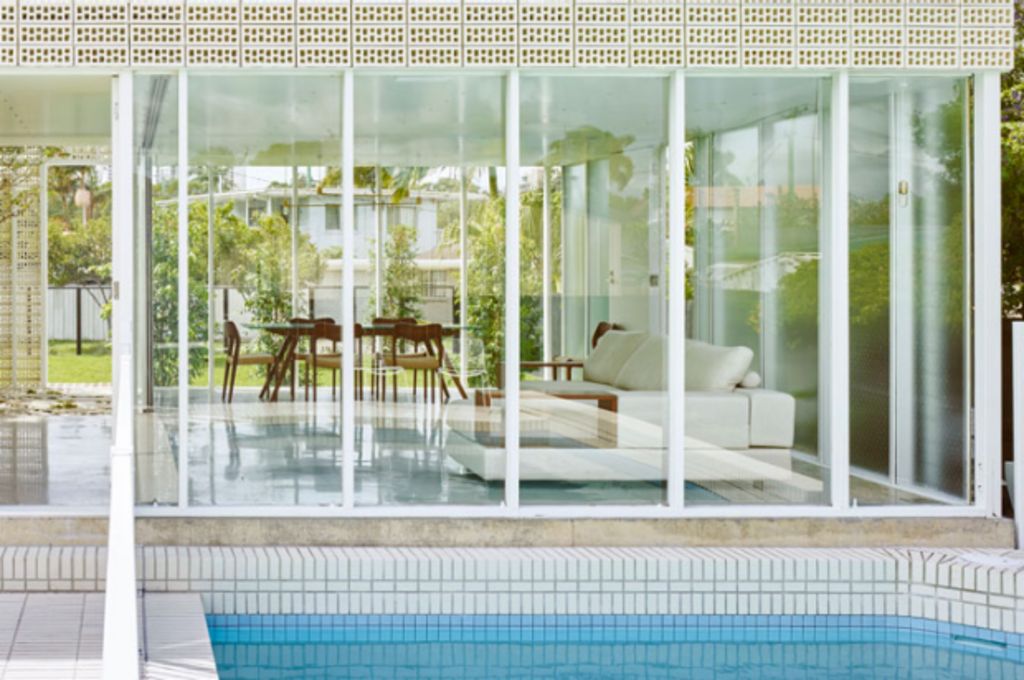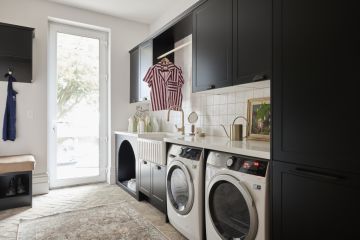Tiny Brisbane house and Sydney apartment big winners at 2016 Houses Magazine Awards

A Queensland home paying homage to breezeblocks and the style of the 1960s has won a major architecture award for Australia’s best small house.
Naranga Avenue House by Brisbane architect James Russell, which resembles a glowing lantern with the lights on, was the category winner for houses under 200 metres squared at the Houses Magazine House of the Year, announced in Sydney on Friday.
The competition judges say the diversity of the entrants shows that architecture in Australia is changing as clients are opting for simple, sleek designs and a focus on the outdoor.
The focus is no longer about houses on a quarter acre block and spaces that are intimate and creative, rather than big and lavish, are in hot demand.
The fact that an apartment won House of the Year may be the key indicator that design taste in Australia is changing.
Friday marked the second time this year that a wood-adorned apartment by Sydney firm Chenchow Little won the top gong at an architecture awards night – also named Interior of the Year by Australian Interior Design Awards in June.
On the waterfront in Sydney’s Darling Point, the apartment was built to stylishly showcase the client’s 26 piece art collection, and embraces fluid geometry, wood panelling and mirrored bathrooms.
 The Darling Point Apartment by Chenchow Little – the winner of the House of the Year award. Image: Peter Bennetts
The Darling Point Apartment by Chenchow Little – the winner of the House of the Year award. Image: Peter Bennetts
Juror and Editor of Houses magazine Katelin Butler said the jury could see an appreciation for art and detail reflected in every part of the home design.
“Nothing is average in this apartment, from the way that they’ve housed the art and the way they’ve used the fantastic view.
“We’ve never had an apartment win before and it reveals the diversity of living in Australia. It shows that you don’t need a huge amount of space but if you design it well it can have the same level of comfort and sophistication as a large detached house.”
While the judges praised Chenchow Little’s use of a smaller space, James Russell also says the brief he received for a modest home was a delight.
“It’s wonderful when clients come to you to live in a particular way which is deeply modest, this project was for a young family who asked me to build the space they needed and nothing more.
“The most desirable spots in the house are the spaces where you know what’s going on, it encourages the family to communicate more with each other.”
The house belongs to a young family in the suburb of Florida Gardens, where the Gold Coast’s first housing estates were built in the 1960s.
Forming a shell around the exterior, the clay breezeblocks provide crucial protection from the Queensland sun but allow a constant airflow meaning al fresco dining is the norm.
The house reflects the feel of 1960s suburbia, except for perhaps the modern addition of the indoor tree, and hole through the middle of the house.
Juror Katelin Butler said the project is a gem within its neighbourhood.
“There’s a sublime, ephemeral quality to it. It has a very clear idea of shelter, and the pockets of the courtyard are completely integrated into the living spaces so you don’t feel like there’s any separation between inside and out.”
Not all projects opted for small spaces of course, and sitting on the rocks of south Bondi beach is ‘Deepwater’ by Tobias Partners, awarded the Best New House over 200 square metres.
 The Fairfield House by Kennedy Nolan won the Outdoor and Sustainability categories. Image: Derek Swalwell
The Fairfield House by Kennedy Nolan won the Outdoor and Sustainability categories. Image: Derek Swalwell
Another big winner on the night was the ‘Fairfield House’ by Kennedy Nolan in collaboration with Sam Cox Landscape, which took out first prize in the Sustainability and Outdoor categories, the judges admiring the architect’s efforts to regenerate the environment.
The judges said that while sustainability should be incorporated in all architecture, the Fairfield House went above and beyond to rehabilitate the bushland surrounding the pool and garden.
This year the House of the Year awards received 427 entries, with winners picked from a shortlist of 152 projects in 10 categories.
Winners at the Houses Magazine House of the Year awards 2016
Australian House of the Year – Darling Point Apartment, Chenchow Little
New House under 200 m2– Naranga Avenue House, James Russell Architect
New House over 200 m2 – Deepwater, Tobias Partners
House Alteration and Addition under 200 m2 – Baffle House, Claire Cousins Architects
House Alteration and Addition over 200 m2 – Project Zero, BVN
Apartment or Unit – Darling Point Apartment, Chenchow Little
Outdoor – Fairfield House, Kennedy Nolan in collaboration with Sam Cox Landscape
House in a Heritage Context – Bayside Fire Station, Owen Architecture
Sustainability – Fairfield House, Kennedy Nolan
Emerging Architecture Practice – Rob Kennon Architects
We recommend
We thought you might like
States
Capital Cities
Capital Cities - Rentals
Popular Areas
Allhomes
More







